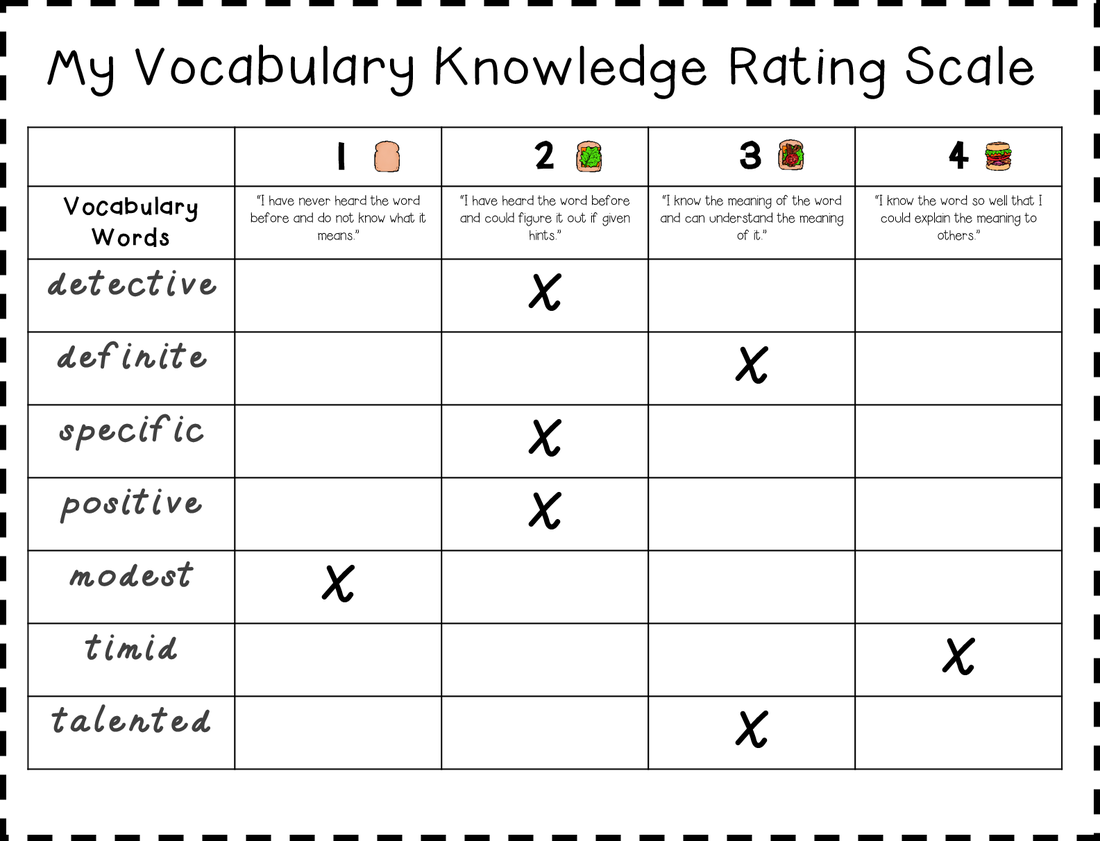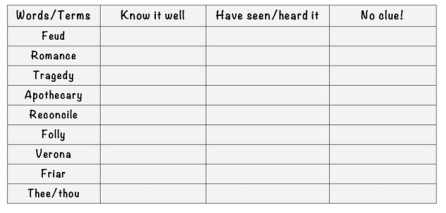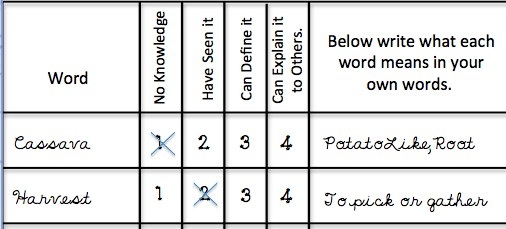Vocabulary Rating Guide
|
With the Vocabulary Rating Guide, students rate their level of understanding of vocabulary terms before, during, and after reading. According to page 19 of Dr. Mimi Miller and Nancy Veatch in their 2011 book entitled Literacy in Context (LinC): Choosing Instructional Strategies to Teach Reading in Content Areas for Students Grades 5-12, as students are exposed to content text, students reflect upon their vocabulary knowledge and note their developing understanding.
Vocabulary Rating Guides are a strategy for assessing student prior knowledge about a term by having them individually score themselves on how well the know the vocabulary. |
Miller and Veatch's 2011 Guide to:
Creating a Vocabulary Rating GUIDE
1. (Before reading) Provide students with a list of essential vocabulary words (up to 12) chosen from the text on a Vocabulary Rating Guide.
2. Read aloud to the students each word on the list, and have students repeat it. The read-repeat process helps students hear the word and practice saying it so they are able to pronounce it appropriately and thus more capable of using it independently in their reading.
3. For each word, use it in a sentence, but don’t give the students a definition. For example, if the term is “tyrant,” the sentence would be: “The tyrant was the ruler of the third Chinese Dynasty.” Some words can be used as both nouns and verbs, so giving students a sentence helps them recognize the part of speech you are asking them to use for the vocabulary word you have selected.
4. Students then rate their understanding of each word on a scale from 1 to 4 in the “Before Reading” section.
6. Together, partners find the word in the text and highlight it or mark it with a sticky note. They read the word in context, think about the definition they have located in the dictionary, and decide which definition is the most clear.
7. Students then record a definition for each word, including a synonym. Information for this definition comes from the previous stages of the activity. (If teachers are pressed for time, they can divide the class into pairs, and have each pair complete the definition and synonym steps for only one word.)
8. As a class, students share what they have learned about each word. (If the class has been divided into pairs, the teacher leads the class in completing the definition and synonym portion of the Vocabulary Rating Guide together.)
9. (During reading) Students use the Vocabulary Rating Guide during the reading of the text passage to review word meaning.
10. (After reading) After the text reading has been completed, students revisit the Vocabulary Rating Guide and complete the “After Reading” rating section to see if they have made vocabulary growth over time. The teacher says each word. Students rate their new understanding, assigning a 1, 2, 3, or 4. If a student has rated his or her understanding as either 3 or 4, the teacher can challenge him or her to put that word in a sentence.
11. Debrief about how students’ understanding of the key terms improved during the lesson. The teacher can also request that students show a hand signal—thumbs up (increase), thumbs down (decrease), or a flat hand (no change) to show whether their rating changed over time.
2. Read aloud to the students each word on the list, and have students repeat it. The read-repeat process helps students hear the word and practice saying it so they are able to pronounce it appropriately and thus more capable of using it independently in their reading.
3. For each word, use it in a sentence, but don’t give the students a definition. For example, if the term is “tyrant,” the sentence would be: “The tyrant was the ruler of the third Chinese Dynasty.” Some words can be used as both nouns and verbs, so giving students a sentence helps them recognize the part of speech you are asking them to use for the vocabulary word you have selected.
4. Students then rate their understanding of each word on a scale from 1 to 4 in the “Before Reading” section.
- I don’t recognize this word, and I have never heard it before.
- I recognize the word, but I don’t know what it means.
- I have a basic understanding of the word.
- I understand the word and can use it flexibly, in most contexts. I could teach it to others.
6. Together, partners find the word in the text and highlight it or mark it with a sticky note. They read the word in context, think about the definition they have located in the dictionary, and decide which definition is the most clear.
7. Students then record a definition for each word, including a synonym. Information for this definition comes from the previous stages of the activity. (If teachers are pressed for time, they can divide the class into pairs, and have each pair complete the definition and synonym steps for only one word.)
8. As a class, students share what they have learned about each word. (If the class has been divided into pairs, the teacher leads the class in completing the definition and synonym portion of the Vocabulary Rating Guide together.)
9. (During reading) Students use the Vocabulary Rating Guide during the reading of the text passage to review word meaning.
10. (After reading) After the text reading has been completed, students revisit the Vocabulary Rating Guide and complete the “After Reading” rating section to see if they have made vocabulary growth over time. The teacher says each word. Students rate their new understanding, assigning a 1, 2, 3, or 4. If a student has rated his or her understanding as either 3 or 4, the teacher can challenge him or her to put that word in a sentence.
11. Debrief about how students’ understanding of the key terms improved during the lesson. The teacher can also request that students show a hand signal—thumbs up (increase), thumbs down (decrease), or a flat hand (no change) to show whether their rating changed over time.
Examples and Resources
ExamplesLanguage Arts Lesson
- Shakespeare Knowlege Rating Scale for Math - From the West Virginia Department of Education Vocabulary Rating Scale Examples - Blog |
ResourcesAdapted Knowledge Rating Scale Template
In Word Vocabulary Knowledge Checklist From Keys to Literacy Vocabulary Knowledge Rating Sheet Implementation Tips Knowledge Rating Chart Five Level Chart Vocabulary Knowledge Rater From Silver& Strong Associates |
Resources
Enome, inc. (2015). Vocabulary knowledge rating sheet. Retrieved from https://goalbookapp.com/toolkit/strategy/vocabulary-knowledge-rating-sheet
Fausnight, A. (2012). Know or no? Retrieved from https://devotedtovocabulary.files.wordpress.com/2012/07/know-or-no.png
Keys to Literacy. (2015). Vocabulary knowledge rating checklists. Retrieved from https://keystoliteracy.com/wp-content/pdfs/5b-wkshp-templates/vocabulary-rating-checklist.pdf
Knatim. (2009). Summarization 1 establishing a learning focus. Retrieved from https://www.youtube.com/watch?v=iIyB1ffhBzM
Korty, M. (2014). Vocabulary in the common core era. Retrieved from http://teachingtakesthecake.blogspot.com/2014/08/vocabulary-in-common-core-era.html
Miller, M., & Veatch, N. (2011). Literacy in context (LinC): Choosing instructional strategies to teach reading in content areas for students grades 5-12. Boston: Pearson.
National Behaviour Support Service. (2015). Vocabulary/knowledge rating examples. Retrieved from http://education.ky.gov/curriculum/lit/Documents/kclm/vocabulary_rating_comprehension_strategy_teaching%20tools.pdf
Silver Strong & Associates. (2012). Vocabulary knowledge rating organizer. Retrieved from http://www.thoughtfulclassroom.com/tools/PDFs/Vocabulary_Knowledge_Rating_Organizer.pdf
West Virginia Department of Education. (2015). Knowledge rating scale. Retrieved from https://wvde.state.wv.us/strategybank/KnowledgeRatingScale.html
Enome, inc. (2015). Vocabulary knowledge rating sheet. Retrieved from https://goalbookapp.com/toolkit/strategy/vocabulary-knowledge-rating-sheet
Fausnight, A. (2012). Know or no? Retrieved from https://devotedtovocabulary.files.wordpress.com/2012/07/know-or-no.png
Keys to Literacy. (2015). Vocabulary knowledge rating checklists. Retrieved from https://keystoliteracy.com/wp-content/pdfs/5b-wkshp-templates/vocabulary-rating-checklist.pdf
Knatim. (2009). Summarization 1 establishing a learning focus. Retrieved from https://www.youtube.com/watch?v=iIyB1ffhBzM
Korty, M. (2014). Vocabulary in the common core era. Retrieved from http://teachingtakesthecake.blogspot.com/2014/08/vocabulary-in-common-core-era.html
Miller, M., & Veatch, N. (2011). Literacy in context (LinC): Choosing instructional strategies to teach reading in content areas for students grades 5-12. Boston: Pearson.
National Behaviour Support Service. (2015). Vocabulary/knowledge rating examples. Retrieved from http://education.ky.gov/curriculum/lit/Documents/kclm/vocabulary_rating_comprehension_strategy_teaching%20tools.pdf
Silver Strong & Associates. (2012). Vocabulary knowledge rating organizer. Retrieved from http://www.thoughtfulclassroom.com/tools/PDFs/Vocabulary_Knowledge_Rating_Organizer.pdf
West Virginia Department of Education. (2015). Knowledge rating scale. Retrieved from https://wvde.state.wv.us/strategybank/KnowledgeRatingScale.html



